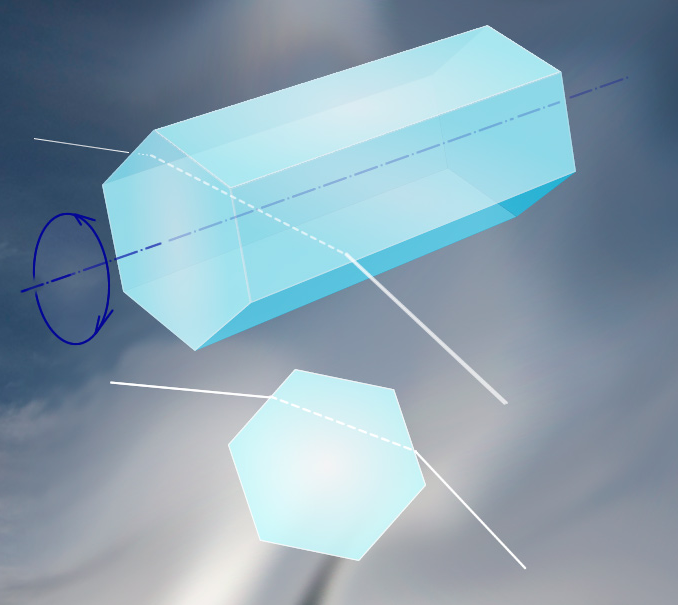Lone Upper Tangent
Lone Upper Tangent: Exploring the Phenomenon
When gazing at the sky, we often marvel at the ethereal beauty of atmospheric optics. One captivating sight that occasionally graces our view is the 'gull wing' shaped upper tangent arc perched atop a 22° halo. However, it is important to note that the upper tangent arc and the halo have separate origins. In this article, we will delve into the intriguing phenomenon of the lone upper tangent arc, shedding light on its formation and unique characteristics.
The upper tangent arc is created by glints of sunlight passing through hexagonal column ice crystals. These crystals are oriented by aerodynamic drag forces, aligning their long 'c' axes to be nearly horizontal. The degree of alignment directly impacts the sharpness of the halo. The better the crystal alignments, the more defined and distinct the upper tangent arc becomes.
It is fascinating to observe that these ice crystals have the ability to assume various rotational positions about their long axis. Although they do not necessarily spin individually, they can take on different orientations within the overall crystal structure. This dynamic nature adds to the complexity and beauty of the upper tangent arc.
To form the upper tangent arc, rays of sunlight pass between two upper prism faces that are inclined at an angle of 60° to each other. It is worth noting that the plane of the ray can be skewed relative to the axis, contributing to the unique shape of the arc. As light passes through the ice crystals, red light is refracted less strongly than blue light. This refraction differential results in a distinctive red fringe along the sunward edge of the upper tangent arc, adding a touch of vivid color to the atmospheric display.
In addition to the upper tangent arc, there exists a counterpart known as the lower tangent arc. Rays passing between lower prism faces give rise to this phenomenon, forming an arc beneath the sun. When the sun climbs above 29°, the upper and lower tangent arcs join together, uniting to create a circumscribed halo. This captivating event provides a mesmerizing spectacle for sky gazers fortunate enough to witness it.
To summarize the key points about the lone upper tangent arc:
- It is formed by glints of sunlight passing through hexagonal column ice crystals.
- The alignment of the crystals' long 'c' axes affects the sharpness of the halo.
- The crystals can assume various rotational positions about their long axis.
- Rays of sunlight pass between two upper prism faces inclined at 60° to each other.
- The plane of the ray can be skewed relative to the axis, contributing to the arc's shape.
- The refraction differential between red and blue light creates a red fringe on the sunward edge.
- The lower tangent arc forms beneath the sun by rays passing between lower prism faces.
- When the sun climbs above 29°, the upper and lower tangent arcs merge to form a circumscribed halo.
The lone upper tangent arc is a testament to the intricacies and wonders of atmospheric optics. It serves as a reminder of the beauty and complexity that can be found in the natural world. So, next time you find yourself gazing at the sky, keep an eye out for this elusive phenomenon and let it inspire you with its celestial splendor.

Lone Halo, Norway ~ Upper tangent arc imaged by Lars Brubæk February 25, 2010. The location is Ytre (outer) Bogge , a small community on the eastern shore of Eresfjord. ©Lars Brubæk, shown with permission.
We usually see a 'gull wing' shaped upper tangent arc atop a 22° halo. However, the two halos have separate origins.
The upper tangent arc is the glints of sunlight passing through hexagonal column ice crystals oriented by aerodynamic drag forces to have their long 'c' axes nearly horizontal. The better the crystal alignments, the sharper is the halo.
The crystals can take all rotational positions about the long axis although they do not necessarily individually 'spin'.
The rays pass between two upper prism faces inclined 60° to each other. The plane of the ray can be skewed relative to the axis.
Red light is refracted less strongly than blue giving the halo a red fringe on its sunward edge.
Equivalent rays passing between lower prism faces give a 'lower tangent arc' beneath the sun.
When the sun climbs above 29° the upper and lower tangent arcs join to form a circumscribed halo.

Note: this article has been automatically converted from the old site and may not appear as intended. You can find the original article here.
Reference Atmospheric Optics
If you use any of the definitions, information, or data presented on Atmospheric Optics, please copy the link or reference below to properly credit us as the reference source. Thank you!
-
<a href="https://atoptics.co.uk/blog/lone-upper-tangent/">Lone Upper Tangent</a>
-
"Lone Upper Tangent". Atmospheric Optics. Accessed on November 16, 2024. https://atoptics.co.uk/blog/lone-upper-tangent/.
-
"Lone Upper Tangent". Atmospheric Optics, https://atoptics.co.uk/blog/lone-upper-tangent/. Accessed 16 November, 2024
-
Lone Upper Tangent. Atmospheric Optics. Retrieved from https://atoptics.co.uk/blog/lone-upper-tangent/.